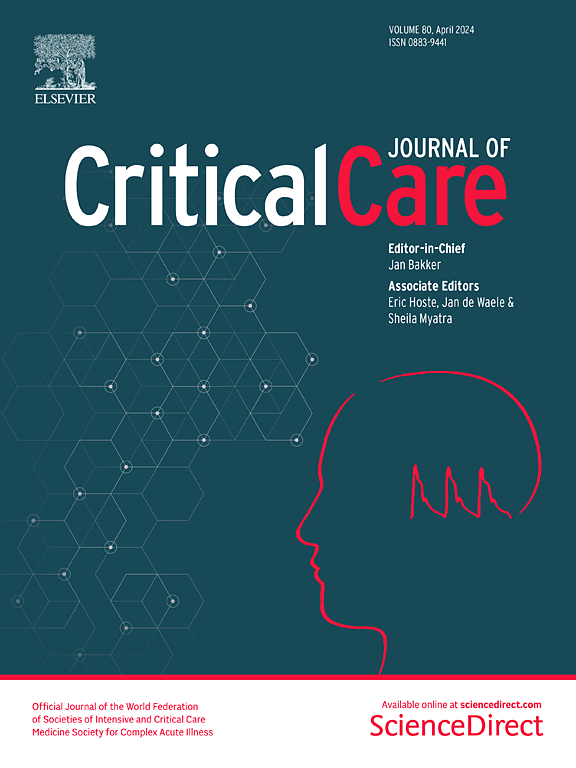Redefining urine output thresholds for acute kidney injury criteria in critically Ill patients: a derivation and validation study
IF 8.8
1区 医学
Q1 CRITICAL CARE MEDICINE
引用次数: 0
Abstract
The current definition of acute kidney injury (AKI) includes increased serum creatinine (sCr) concentration and decreased urinary output (UO). Recent studies suggest that the standard UO threshold of 0.5 ml/kg/h may be suboptimal. This study aimed to develop and validate a novel UO-based AKI classification system that improves mortality prediction and patient stratification. Data were obtained from the MIMIC-IV and eICU databases. The development process included (1) evaluating UO as a continuous variable over 3-, 6-, 12-, and 24-h periods; (2) identifying 3 optimal UO cutoff points for each time window (stages 1, 2, and 3); (3) comparing sensitivity and specificity to develop a unified staging system; (4) assessing average versus persistent reduced UO hourly; (5) comparing the new UO-AKI system to the KDIGO UO-AKI system; (6) integrating sCr criteria with both systems and comparing them; and (7) validating the new classification with an independent cohort. In all these steps, the outcome was hospital mortality. Another analyzed outcome was 90-day mortality. The analyses included ROC curve analysis, net reclassification improvement (NRI), integrated discrimination improvement (IDI), and logistic and Cox regression analyses. From the MIMIC-IV database, 35,845 patients were included in the development cohort. After comparing the sensitivity and specificity of 12 different lowest UO thresholds across four time frames, 3 cutoff points were selected to compose the proposed UO-AKI classification: stage 1 (0.2–0.3 mL/kg/h), stage 2 (0.1–0.2 mL/kg/h), and stage 3 (< 0.1 mL/kg/h) over 6 h. The proposed classification had better discrimination when the average was used than when the persistent method was used. The adjusted odds ratio demonstrated a significant stepwise increase in hospital mortality with advancing UO-AKI stage. The proposed classification combined or not with the sCr criterion outperformed the KDIGO criteria in terms of predictive accuracy—AUC-ROC 0.75 (0.74–0.76) vs. 0.69 (0.68–0.70); NRI: 25.4% (95% CI: 23.3–27.6); and IDI: 4.0% (95% CI: 3.6–4.5). External validation with the eICU database confirmed the superior performance of the new classification system. The proposed UO-AKI classification enhances mortality prediction and patient stratification in critically ill patients, offering a more accurate and practical approach than the current KDIGO criteria.重新定义重症患者急性肾损伤标准的尿量阈值:推导和验证研究
目前急性肾损伤(AKI)的定义包括血清肌酐(sCr)浓度升高和尿量(UO)减少。最近的研究表明,0.5 毫升/千克/小时的标准尿量阈值可能并不理想。本研究旨在开发和验证一种新型的基于尿量的 AKI 分类系统,该系统可改善死亡率预测和患者分层。数据来自 MIMIC-IV 和 eICU 数据库。开发过程包括:(1)将尿氧饱和度作为一个连续变量,在 3、6、12 和 24 小时内进行评估;(2)为每个时间窗(阶段 1、2 和 3)确定 3 个最佳尿氧饱和度临界点;(3)比较灵敏度和特异性,以开发一个统一的分期系统;(4) 评估平均 UO 小时数与持续减少 UO 小时数;(5) 将新的 UO-AKI 系统与 KDIGO UO-AKI 系统进行比较;(6) 将 sCr 标准纳入这两个系统并进行比较;(7) 通过独立队列验证新的分类。所有这些步骤的结果都是住院死亡率。另一个分析结果是 90 天死亡率。分析包括 ROC 曲线分析、净再分类改进(NRI)、综合辨别改进(IDI)以及逻辑和 Cox 回归分析。在 MIMIC-IV 数据库中,35,845 名患者被纳入开发队列。在比较了 12 种不同的最低 UO 临界值在四个时间范围内的灵敏度和特异性后,选出了 3 个临界点来组成拟议的 UO-AKI 分类:6 小时内的第 1 阶段(0.2-0.3 mL/kg/h)、第 2 阶段(0.1-0.2 mL/kg/h)和第 3 阶段(< 0.1 mL/kg/h)。调整后的几率比表明,随着 UO-AKI 阶段的增加,住院死亡率也会显著增加。无论是否结合 sCr 标准,建议的分类在预测准确性方面都优于 KDIGO 标准--AUC-ROC 0.75 (0.74-0.76) vs. 0.69 (0.68-0.70);NRI:25.4% (95% CI:23.3-27.6);IDI:4.0% (95% CI:3.6-4.5)。eICU 数据库的外部验证证实了新分类系统的卓越性能。与目前的 KDIGO 标准相比,所提出的 UO-AKI 分级提高了重症患者的死亡率预测和患者分层能力,提供了一种更准确、更实用的方法。
本文章由计算机程序翻译,如有差异,请以英文原文为准。
求助全文
约1分钟内获得全文
求助全文
来源期刊

Critical Care
医学-危重病医学
CiteScore
20.60
自引率
3.30%
发文量
348
审稿时长
1.5 months
期刊介绍:
Critical Care is an esteemed international medical journal that undergoes a rigorous peer-review process to maintain its high quality standards. Its primary objective is to enhance the healthcare services offered to critically ill patients. To achieve this, the journal focuses on gathering, exchanging, disseminating, and endorsing evidence-based information that is highly relevant to intensivists. By doing so, Critical Care seeks to provide a thorough and inclusive examination of the intensive care field.
 求助内容:
求助内容: 应助结果提醒方式:
应助结果提醒方式:


